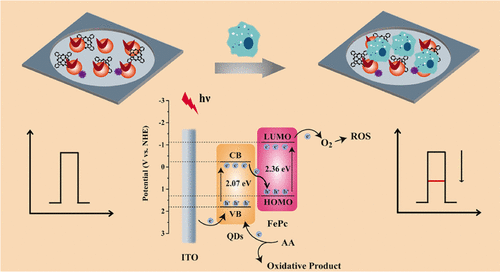当前位置:
X-MOL 学术
›
ACS Appl. Mater. Interfaces
›
论文详情
Our official English website, www.x-mol.net, welcomes your
feedback! (Note: you will need to create a separate account there.)
Formation of a Photoelectrochemical Z-Scheme Structure with Inorganic/Organic Hybrid Materials for Evaluation of Receptor Protein Expression on the Membrane of Cancer Cells.
ACS Applied Materials & Interfaces ( IF 8.3 ) Pub Date : 2020-05-19 , DOI: 10.1021/acsami.0c04949 Zizheng Wang 1 , Jing Li 1 , Wenwen Tu 1 , Huaisheng Wang 2 , Zhaoyin Wang 1 , Zhihui Dai 1
ACS Applied Materials & Interfaces ( IF 8.3 ) Pub Date : 2020-05-19 , DOI: 10.1021/acsami.0c04949 Zizheng Wang 1 , Jing Li 1 , Wenwen Tu 1 , Huaisheng Wang 2 , Zhaoyin Wang 1 , Zhihui Dai 1
Affiliation

|
Quantitative analysis of receptor protein expression is essential to give new insights into tumor-related research. Benefitting from their high sensitivity and low background, photoelectrochemical (PEC) platforms are considered as powerful tools for evaluating the expression of receptor proteins. Herein, to reduce the cytotoxicity and facilitate the subsequent assembly, l-cysteine-modified Ag–ZnIn2S4 quantum dots (l-Cys AZIS QDs) are prepared and PEC responses under the irradiation of long wavelength light are obtained. To further improve the PEC behavior, iron phthalocyanine (FePc) is employed to form a Z-scheme structure with l-Cys AZIS QDs. The Z-scheme structure based on l-Cys AZIS QDs/FePc hybrid materials exhibits high photo-to-electric conversion efficiency and can be excited with near-infrared range light. Because hyaluronic acid linked to photoactive materials can recognize CD44 expressed on the membrane of cancer cells, cancer cells are immobilized onto l-Cys AZIS QDs/FePc hybrid materials, inducing a decrease of the photocurrent intensity. Consequently, a PEC cytosensor is constructed to quantify cancer cells expressing CD44. The PEC analytical platform is able to determine A549 cells in the range of 2 × 102 to 4.5 × 106 cells/mL, and a detection limit of 15 cells/mL is realized in the case of S/N = 3. In addition, the expression of CD44 in A549 and other five cancer cells is measured with this PEC method. Depending on our data, the expression of CD44 in different cancer cells is distinct, indicating great potential of this method in receptor protein-related studies.
中文翻译:

用无机/有机杂化材料形成光电化学Z方案结构,用于评估癌细胞膜上受体蛋白的表达。
受体蛋白表达的定量分析对于为肿瘤相关研究提供新见解至关重要。得益于其高灵敏度和低背景,光电化学(PEC)平台被认为是评估受体蛋白表达的强大工具。在本文中,为了降低细胞毒性并促进后续组装,制备了1-半胱氨酸修饰的Ag-ZnIn 2 S 4量子点(1 -Cys AZIS QDs),并获得了在长波长光照射下的PEC响应。为了进一步改善PEC行为,铁酞菁(FePc)用于形成具有1- Cys AZIS QD的Z型结构。该ž基于l -Cys AZIS QDs / FePc杂化材料的化学结构显示出高的光电转换效率,并且可以被近红外范围的光激发。因为与光敏材料连接的透明质酸可以识别癌细胞膜上表达的CD44,所以癌细胞被固定在1- Cys AZIS QDs / FePc杂化材料上,从而导致光电流强度降低。因此,构建了PEC细胞传感器以定量表达CD44的癌细胞。PEC分析平台能够确定2×10 2至4.5×10 6范围内的A549细胞S / N = 3的情况下,检测限为15个细胞/ mL。此外,用此PEC方法测定了A549和其他五个癌细胞中CD44的表达。根据我们的数据,CD44在不同癌细胞中的表达是不同的,这表明该方法在受体蛋白相关研究中具有巨大潜力。
更新日期:2020-05-19
中文翻译:

用无机/有机杂化材料形成光电化学Z方案结构,用于评估癌细胞膜上受体蛋白的表达。
受体蛋白表达的定量分析对于为肿瘤相关研究提供新见解至关重要。得益于其高灵敏度和低背景,光电化学(PEC)平台被认为是评估受体蛋白表达的强大工具。在本文中,为了降低细胞毒性并促进后续组装,制备了1-半胱氨酸修饰的Ag-ZnIn 2 S 4量子点(1 -Cys AZIS QDs),并获得了在长波长光照射下的PEC响应。为了进一步改善PEC行为,铁酞菁(FePc)用于形成具有1- Cys AZIS QD的Z型结构。该ž基于l -Cys AZIS QDs / FePc杂化材料的化学结构显示出高的光电转换效率,并且可以被近红外范围的光激发。因为与光敏材料连接的透明质酸可以识别癌细胞膜上表达的CD44,所以癌细胞被固定在1- Cys AZIS QDs / FePc杂化材料上,从而导致光电流强度降低。因此,构建了PEC细胞传感器以定量表达CD44的癌细胞。PEC分析平台能够确定2×10 2至4.5×10 6范围内的A549细胞S / N = 3的情况下,检测限为15个细胞/ mL。此外,用此PEC方法测定了A549和其他五个癌细胞中CD44的表达。根据我们的数据,CD44在不同癌细胞中的表达是不同的,这表明该方法在受体蛋白相关研究中具有巨大潜力。
















































 京公网安备 11010802027423号
京公网安备 11010802027423号